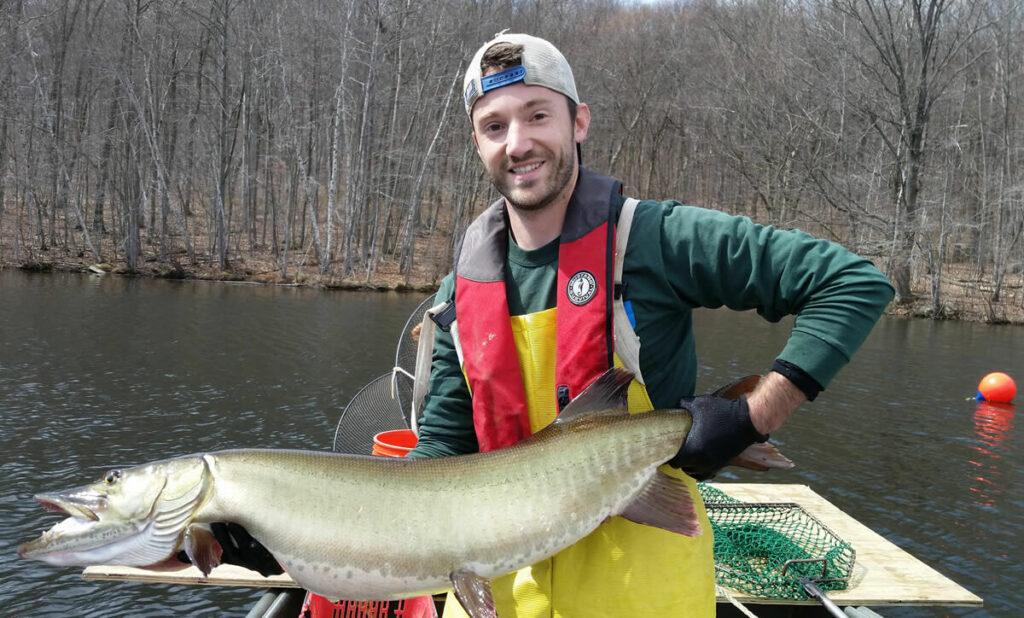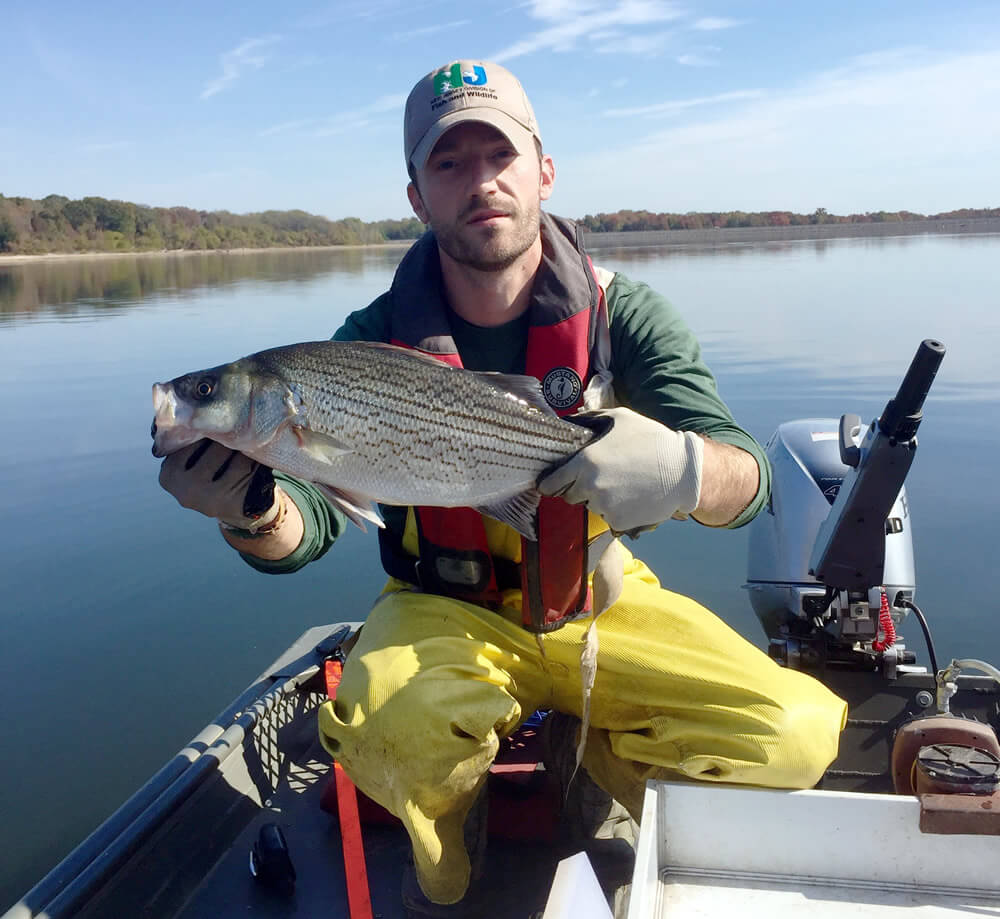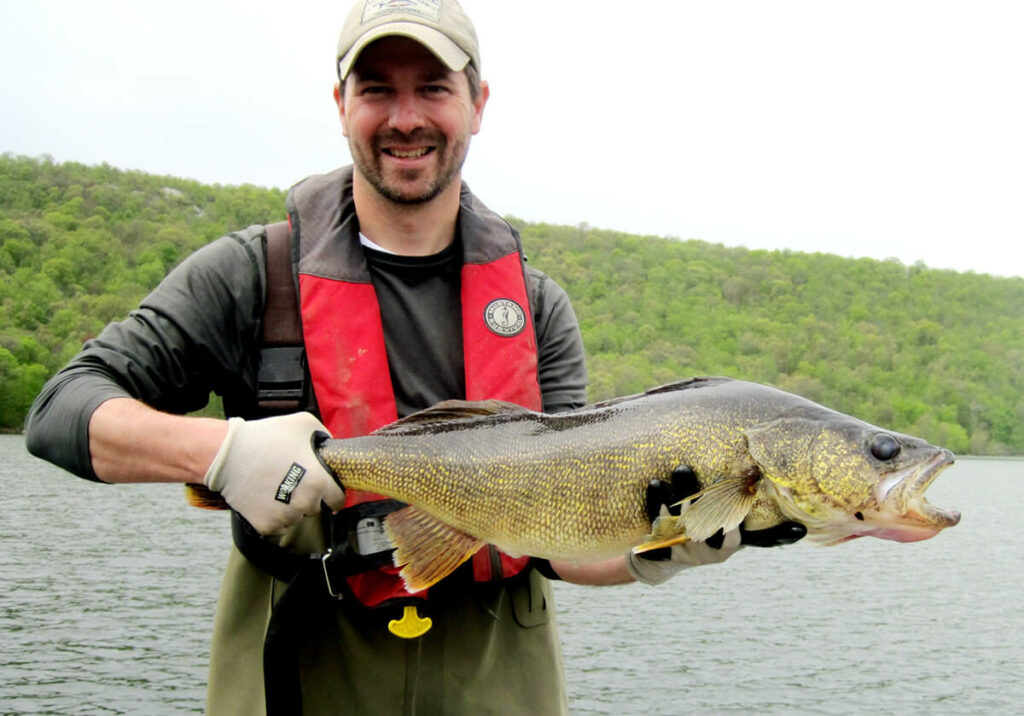
Print version (pdf, 145kb)
Complete Coolwater Assessment Report 2015 (pdf, 340kb)
The Coolwater Fisheries Assessment was initiated in 2013 to evaluate coolwater fisheries that are maintained by annual stockings (Muskellunge, Northern Pike, Walleye, and Hybrid Striped Bass) from the Hackettstown State Fish Hatchery.
In 2013 the focus was on developing sampling techniques and protocols for assessing Muskellunge, which are stocked in ten waterbodies statewide. Three of these lakes (Carnegie Lake, Furnace Lake, and Mountain Lake) were selected for sampling in 2013 using trap nets during the spring when mature muskies congregate for spawning and are more vulnerable to capture. In 2014, the second year of the Coolwater Assessment, four waterbodies (Farrington Lake, Lake Hopatcong, Monksville Reservoir, and Pompton Lake) were selected for spring trap netting surveys to assess one or more species (Northern Pike/Muskellunge/Walleye).
2015 Coolwater Fisheries Assessment Summary
In 2015 seven waterbodies were sampled (Canistear Reservoir, Furnace Lake, Manasquan Reservoir, Mercer Lake, Monksville Reservoir, Spruce Run Reservoir, and Swartswood Lake). A total of 73 trap nets, 9 overnight gill net sets, and 5 nights of boat electrofishing were utilized to capture the target species of interest from each waterbody. Trap net sampling for Muskies and Pike, delayed by late ice-out, commenced in early April, multiple nighttime boat electrofishing surveys were conducted in the fall to target Walleye, and gill nets were set in the fall to target Hybrid Striped Bass.
The results from these surveys are summarized below by waterbody and are presented with greater detail in the 2015 Coolwater Assessment Report.
Canistear Reservoir
Walleye were targeted at Canistear Reservoir during fall nighttime electrofishing. On October 13 a total of 21 Walleye, 67 Smallmouth Bass, and 13 Largemouth Bass were captured over 1.2 hrs of electrofishing. Smallmouth Bass were found to be most abundant with a catch per unit effort (CPUE) of 42 fish/hr. The Walleye population was only moderately abundant with a CPUE of 8 fish/hr, another example of low CPUE during fall nighttime electrofishing for Walleye. Of those Walleye captured, most were larger individuals indicated by a PSD of 80 and RSDp of 30. The Walleye population will continue to be monitored at this reservoir to obtain more data.
Furnace Lake:
This 53-acre lake located in Oxford Township, was sampled for Muskellunge using trap nets between April 22nd and April 24th. A total of 9 trap nets were set and 3 Muskellunge and 1 Tiger Muskellunge were captured. They ranged in size from 33-42 in. and 8.0-25.4 lbs. respectively (see photo). This catch rate is almost double the standard used in Pennsylvania for a good Muskellunge fishery (1 Muskellunge for every 4 trap nets) and indicates an abundant population of Muskellunge. Anglers actively fishing when crews were present indicated that they catch Muskellunge with regularity at Furnace Lake and it is not unusual to catch three in one day, which is an extremely good catch rate for Muskellunge using hook and line.
Manasquan Reservoir
At Manasquan Reservoir the target species for trap netting was Muskellunge and the catch was low. Only one individual was captured (CPUE of 0.1 fish/net). The Muskellunge was large at 963 mm (38 in) and weighed 8 kg (17.6 lb). Manasquan Reservoir proved difficult to sample as it lacks a variety of points and inlets that trap nets are set near to capture Muskellunge. Hybrid Striped Bass are also stocked annually in the reservoir and to assess this fishery, a total of four 120ft experimental gill nets were set between October 21 and 22. A total of 3 Hybrid Striped Bass were captured during this sampling. Because of the low catch rate in 2015, more sampling for Hybrid Striped Bass took place in 2016. On October 18 to 19, 2016 a total of four 120ft experimental gill nets were set. Nine Hybrid Striped Bass were captured. These numbers are considered low and may be a concern. This population will continue to be monitored closely.
Mercer Lake:
A total of 6,247 fish were captured in the trap nets at Mercer Lake. White Perch were the most common fish species present, composing 91.2% of the catch. A total of twelve species of fish were collected during this trap net survey. The target species, Muskellunge, was not captured during the survey.
Monksville Reservoir
At Monksville Reservoir the target species for trap netting were Walleye and Muskellunge. Walleye were found to be fairly abundant (41 total) with a CPUE of 2.6 fish/net. The Pennsylvania Fish and Boat Commission developed trap net standards for medium sized reservoirs (50-500 acres) which are 4.8 Walleye/net during the early spring and 1.8 Walleye/net post spawn. The timing of trap netting coincided with the tail end of spawning and this resulted in a reduced catch rate. The Walleye captured were composed of mostly larger individuals indicated by a PSD of 85, RSDp of 75, and RSDm of 50, but there were a good number of individuals representing a variety of age classes. The relative weight (Wr) metric indicated Walleye were in below average condition (average Wr of 90 ± 3), but this is expected for post spawn fish.
Muskellunge were also targeted at Monksville Reservoir and found to be fairly abundant (4 total caught) with a CPUE of 0.3 fish/net. Pennsylvania Fish and Boat Commission developed trap net standards for capturing Muskellunge via trap nets in which a quality Muskellunge fishery will encounter 0.25 Muskellunge/trap net (1 Muskellunge for every 4 nets set). Applying this standard to our catch rate, Monksville Reservoir has a quality Muskellunge fishery. The sizes of Muskellunge captured were composed of larger individuals indicated by a PSD of 75, RSDp of 75, and RSDm of 50. The relative weight (Wr) metric indicates the Muskellunge were in slightly below average condition (mean Wr of 94 ± 7) also.
Walleye were also sampled by nighttime electrofishing. During this electrofishing effort, which lasted 1.76 hrs, no Walleye were captured. Historically, sampling at Monksville Reservoir shows that timing of sampling can play a large role in the success of catching the target species with more success for Walleye occurring later in October. Night electrofishing this fall for Walleye was, in general, unsuccessful for all waterbodies sampled.
Spruce Run Reservoir
At Spruce Run Reservoir the target species for trap netting was Northern Pike and the catch of Northern Pike was high (CPUE of 5.1fish/net). A total of 82 Northern Pike were captured and they ranged from 390 – 926 mm (15.4 – 36.5 in) long and 0.37 – 6.58 kg (0.82 – 14.5 lb). Of the Northern Pike captured, the majority were larger individuals (indicated by a PSD of 96 and RSDp of 26), with 59 exceeding the legal size of 24 inches and 27 exceeding a quality size of 30 inches. The condition of Northern Pike was measured using a relative weight metric (Wr). The overall mean Wr for Northern Pike collected was 93 ± 3 and ranged from 67 – 122 which indicates overall condition slightly below average. Hybrid Striped Bass are also stocked annually in this reservoir and to assess this fishery five 120 ft experimental gill nets were set between October 14 and 15. A total of 47 Hybrid Striped Bass were captured representing all size ranges, but most were larger individuals as indicated by the PSD of 93, RSDp 64, and RSDm 18. The Hybrid Striped Bass fishery in this waterbody appears to be healthy and stable.
Swartswood Lake
At Swartswood Lake the target species for spring nighttime electrofishing was Walleye. A total of 3 hours of electrofishing was conducted between two nights in the spring (May 21 and June 2) and Walleye were found to be most abundant species in the lake(CPUE of 15 fish/hr). The Walleye population was represented by mostly larger individuals indicated by a PSD of 85 and RSDp of 43 and the relative weight (Wr) index indicated Walleye were in good condition (average Wr of 100 ± 3). Additional sampling conducted in the fall (October 20th) via nighttime boat electrofishing was not as successful with only 11 Walleye being captured in 1.8 hrs of sampling.
 Official Site of The State of New Jersey
Official Site of The State of New Jersey



